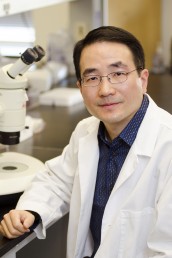Scientists learn how immune cells give chase to germs
Neutrophils move towards the tip of a pipette. Video: Jingsong Xu
How do immune cells hunt down and kill invading pathogens? Theories of the molecular mechanism that enables these cells to chase down their quarry have been around for decades, but without much supporting evidence.
Until now.
Jingsong Xu of the University of Illinois at Chicago College of Medicine and colleagues describe the molecular reactions that allow for directed movement of neutrophils, the body’s first line of defense against harmful bacteria or viruses that have entered the bloodstream. The study is published in the Journal of Experimental Medicine.
Neutrophils hunt down, engulf, and destroy disease-causing intruders in active pursuit. How they do so has mainly been the subject of conjecture.
Many cells begin to move by extending a pseudopod, or false-foot, towards their goal. The foot pulls the rest of the cell forward, and a new pseudopod reaches out again. If the cell is really hustling, extension of the pseudopod and follow-through of the trailing edge occur continuously.
Biologists had thought that this movement was directed by the cell receiving a signal molecule given off by a target, triggering a change in the cell membrane near the signal that would lead to extension of a pseudopod in that direction — along with the release of a quick-diffusing inhibitor to block the formation of pseudopods on any other side of the cell.
But evidence for the “inhibition theory” was lacking.
To uncover exactly how these immune cells give chase, Xu — along with colleagues at UIC including Asrar B. Malik, professor and head of pharmacology, and collaborators at Japan’s Osaka University and the Chinese Academy of Sciences in Beijing — analyzed the biochemical reactions in neutrophils and looked for a difference between those at rest and those in active pursuit.
“Understanding what keeps a neutrophil at rest was a really important first step,” said Xu, who is assistant professor of pharmacology at UIC.
Immobile neutrophils are essentially round, he said. To extend a pseudopod in the forward direction, the first thing the cell needs to do is break that roundness.
The researchers found that in resting neutrophils, a protein called moesin was active throughout the cell membrane. Moesin works to link the cell’s cytoskeleton – the scaffolding that holds the cell’s shape – to its outer membrane and prevents the formation of pseudopods.
“When moesin is active throughout the cell membrane it helps the cell maintain symmetry,” Xu said.
When Xu squirted a known neutrophil attractant out the tip of a tiny pipette into petri dish full of neutrophils, they immediately made for the pipette. Chemical analysis showed that in these mobilizing cells, moesin in the membrane was deactivated where the pseudopod formed, while it remained active at the rear of the cell.
“This is the exact opposite of previous theories that say that inhibition of pseudopods at the back of cells is generated by molecules released at the front end of the cell,” Xu said. “What we found was that inhibition of pseudopod formation is always ‘on’ in resting cells because moesin is in its active state throughout the membrane. During movement, moesin is deactivated only at the front of the cell.”
This localized deactivation at the front — rather than some rapidly-diffusing inhibitor molecule reaching the rear — is what prevents counterproductive pseudopods from forming in the wrong direction, he said.
Other co-authors include Xiaowen Liu, Gang Wang, Luyand Cao, Feng Qian, Shalina Taylor, Richard Ye, Graeme Carnegie, Myung-Jin Oh and Irena Levitan of the UIC College of Medicine; Tao Yang, Shuping Zhou and Yong Zhao of the Institute of Zoology and Chinese Academy of Sciences; and Koya Suzuki, Sachiko Tsukita and Masaru Ishii of Osaka University.
This research was supported in part by National Institutes of Health grant HL095716, Chinese Academic Sciences grant KSCX-W-R-66 and National Science Foundation of China grant 30630037.

